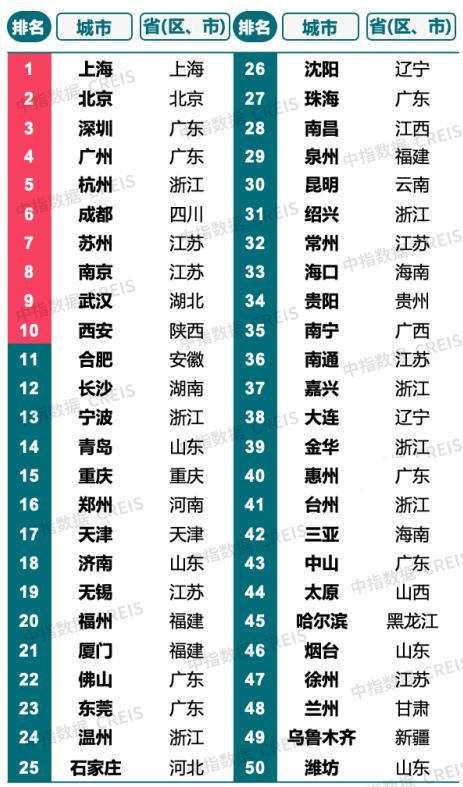
Read More《2025中国城市开发投资吸引力排行榜 上北深广居前四》
Positive Comments: The Investment Attractiveness of Core Cities Stands Out, and New – Quality Productivity Drives New Opportunities for Real Estate Transformation
The release of the 2025 China Urban Development and Investment Attractiveness Ranking is not only an objective summary of the current differentiated pattern of the real estate market but also provides key guidance for the future development of the industry. From the list and the report content, the investment attractiveness of core cities continues to lead. The multiple advantages reflected behind it, such as population, industry, and coordinated development of urban agglomerations, are becoming important supports for the real – estate industry’s transformation to a new model and injecting new impetus into the national strategy of stabilizing domestic demand.
First of all, the positive cycle of “population – industry – housing” in core cities provides the underlying logic for market resilience. The report points out that first – tier cities such as Shanghai, Beijing, Shenzhen, and Guangzhou maintain their leading positions with their economic scale, infrastructure, and talent reserves. New first – tier cities such as Hangzhou, Chengdu, and Hefei attract population inflows through emerging industries such as artificial intelligence, electronic information, and new – energy vehicles. Take Guiyang as an example. In 2024, its permanent population increment ranked first in the country. The core reasons lie in the promotion of the “strong provincial capital” policy, the rapid development of the digital economy and new – energy vehicle industries (such as the battery industry chain supported by phosphorus resources), as well as comprehensive factors such as a reasonable housing – price – to – income ratio and climate advantages. Shenzhen’s population growth also relies on its industrial strength with the “double first” in the total output value of industrial enterprises above the designated size in the country, a liberal household – registration policy, and an inclusive entrepreneurial culture. This positive cycle of “industry attracting talents and talents promoting industry” not only brings stable incremental housing demand to core cities but also promotes the release of improvement – oriented housing demand through the aggregation of high – income groups, forming the market potential of “good cities + good houses”.
Secondly, the rise of new – quality productivity reshapes urban competitiveness and provides more sustainable industrial support for real – estate development. The report shows that in 2024, the proportion of the added value of high – tech manufacturing industries above the designated size in China rose to 16.3%, the output of new – energy vehicles exceeded 13 million, and large – scale artificial – intelligence models were implemented in multiple scenarios. The development of this new – quality productivity has become the core driving force for urban economic growth. For example, driven by enterprises such as BYD, Shenzhen’s output of new – energy vehicles accounted for 22.3% of the national total, defending its title as the “No. 1 city for new – energy vehicles in China”. Relying on enterprises such as BYD and CATL, Hefei has formed a full – industrial – chain layout, and its output of new – energy vehicles increased by 74.6% year – on – year in 2024. In Beijing, due to the hot sales of the Xiaomi SU7, the growth rate of new – energy vehicle output reached 282.7%, ranking first in the country. In the field of artificial intelligence, Beijing, Shanghai, Shenzhen, and Hangzhou have formed differentiated advantages in data circulation, large – model ecosystem, hardware manufacturing, and technology application respectively. The agglomeration of new – quality productivity not only improves the economic quality and employment attractiveness of cities but also drives up the land value of surrounding areas through industrial upgrading, providing opportunities for the integration of “industry + space” for real – estate development, such as talent housing supporting new – energy vehicle industrial parks and industry – city integration projects in science and technology parks.
Thirdly, the coordinated development of core urban agglomerations points out the direction for real – estate enterprises’ strategic layout. The five major core urban agglomerations such as the Yangtze River Delta and the Pearl River Delta, with only 10% of the country’s land area, accommodate more than 40% of the population and more than 50% of the economic aggregate, and the sales area of commercial housing accounts for nearly 50% of the country’s total. Among them, the Yangtze River Delta has become the “preferred investment area” for real – estate enterprises due to the industrial complementarity of multiple core cities such as Shanghai, Hangzhou, Suzhou, and Hefei (such as Shanghai’s finance and technology, Hangzhou’s digital economy, and Hefei’s scientific and technological innovation) and the strong purchasing power of residents (among the cities in the country with the per – capita disposable income of urban residents exceeding 80,000 yuan, eight are in the Yangtze River Delta). From January to May 2025, the proportion of the transfer fees of residential land in the top 10 cities rose to 54% (34% in 2024), further confirming the resource – agglomeration effect of core urban agglomerations. This layout strategy focusing on core urban agglomerations not only conforms to the policy orientation of the linkage mechanism of the elements of “people – housing – land – money” (determining the allocation of housing, land, and funds according to population demand) but also reduces the de – stocking risk of real – estate enterprises in third – and fourth – tier cities due to insufficient demand.
Negative Comments: Intensified Competition in Core Cities and Concerns about Regional Imbalance, Real – Estate Transformation Still Needs to Solve Multiple Challenges
Although the investment attractiveness of core cities has injected confidence into the industry, the list also exposes potential risks in the process of real – estate transformation. The “over – heated competition” that may be caused by excessive focus on core cities, the “demand gap” in third – and fourth – tier cities, and the “growing pains” of industrial upgrading in some cities all need the industry’s attention.
Firstly, the intensified competition in land auctions in core cities drives up costs, and the profit margins of real – estate enterprises are under pressure. The report shows that from January to May 2025, the proportion of the transfer fees of residential land in the top 10 cities jumped from 34% in 2024 to 54%, further intensifying the situation of “too many bidders and too few land parcels” in land auctions in core cities. Taking Shanghai and Hangzhou as examples, the premium rates of high – quality land parcels have continued to rise, and the floor price in some popular areas has approached the price of second – hand houses in the surrounding areas. The phenomenon of “the price of flour being higher than that of bread” may reappear. For real – estate enterprises, although high – price land acquisition can ensure the certainty of de – stocking, it also compresses the profit margin. If the subsequent sales do not meet expectations due to market fluctuations or policy adjustments, it may lead to project losses. In addition, the requirements for building “good houses” in core cities (such as green buildings and intelligent communities) also increase development costs, posing higher requirements for the product strength and cost – control ability of real – estate enterprises.
Secondly, the vicious cycle of “population outflow – insufficient demand – market downturn” in third – and fourth – tier cities is difficult to break, and the problem of regional imbalance is intensifying. The report points out that the national population has declined slightly for three consecutive years, and the urbanization rate has increased to 67% (still lagging behind developed countries). However, the population flow shows the characteristics of “agglomeration in core cities and outflow from third – and fourth – tier cities”. In 2024, except for Guiyang, the population of cities such as Bijie and Zunyi in Guizhou Province decreased significantly. Most cities in the Beijing – Tianjin – Hebei and Shandong Peninsula urban agglomerations are facing population decline pressure. Population outflow directly leads to the shrinkage of housing demand in third – and fourth – tier cities, and some cities are facing the dual pressure of “excessive housing supply + insufficient effective demand”. Although the policy emphasizes that “housing should return to its consumption attribute”, the purchasing power of residents in third – and fourth – tier cities is limited, and the “consumption attribute” lacking industrial support is difficult to support market stability. If real – estate enterprises continue to withdraw from third – and fourth – tier cities, the local land finance and urban construction will be further restricted, and a negative cycle of “investment contraction – economic slowdown – population outflow” may be formed.
Thirdly, the industrial transformation and economic slowdown in some core cities may affect the long – term stability of the real – estate market. For example, Guangzhou’s GDP growth rate was only 2.1% in 2024, mainly dragged down by the automobile manufacturing industry (with the added value decreasing by 18.2% year – on – year) and the downturn of the real – estate market. Shanghai’s output of new – energy vehicles decreased slightly by 4.8% year – on – year, indicating the transformation pressure of traditional automobile enterprises. These phenomena show that even in core cities, if the pillar industries (such as the automobile and traditional manufacturing industries) fail to transform into new – quality productivity in a timely manner, they may face the risk of economic slowdown, which in turn affects residents’ income expectations and housing demand. In addition, the population in first – tier cities such as Beijing and Shanghai has changed from growth to decline (decreasing by 26,000 and 72,000 people respectively in 2024). Although this is related to the policy orientation of “controlling the population scale”, the slowdown of population growth may still have an impact on the long – term incremental housing demand.
Suggestions for Entrepreneurs: Seize Opportunities in Core Cities, Take Regional Differences into Account, and Break the Deadlock with “Product Strength + Industry Integration”
Facing the current pattern of differentiated urban investment attractiveness, entrepreneurs need to find a balance between core cities and potential regions based on their own resources and industry trends, and focus on the following directions:
-
Focus on the integration opportunities of “new – quality productivity + housing demand” in core cities. The new – quality productivity in core cities (such as new – energy vehicles, artificial intelligence, and biomedicine) is developing rapidly. Entrepreneurs can develop “industry – supporting” housing products around the talent needs of these industries. For example, layout talent apartments and improved communities around new – energy vehicle industrial parks, or build “smart communities” (integrating functions such as intelligent security and energy management) in artificial – intelligence parks to meet the demand for high – quality living of high – income and high – knowledge groups. At the same time, pay attention to the requirements for building “good houses” in core cities, and improve the green and intelligent levels of products. For example, use passive building technology to reduce energy consumption, or introduce an AI property – management system to improve service efficiency and enhance project competitiveness.
-
Pay attention to the double – growth dividends of “population – industry” in new first – tier cities. New first – tier cities such as Guiyang, Hefei, and Changsha are becoming new investment hotspots due to the “strong provincial capital” policy, the agglomeration of emerging industries, and population inflows. Entrepreneurs can focus on the industrial planning of these cities (such as big data in Guiyang and new – energy vehicles in Hefei), and combine the advantage of a reasonable housing – price – to – income ratio (such as the housing price in Guiyang being 8,000 – 9,000 yuan per square meter) to develop housing products that combine “cost – effectiveness + quality”. For example, for the first – home demand of young industrial talents, launch small – sized, low – priced but well – equipped (such as close to the subway and the business district) residential buildings; for the improvement demand, build “ecological + educational” composite communities, and use Guiyang’s climate advantage or Hefei’s scientific and technological innovation atmosphere to increase the added value of the project.
-
Be cautious in laying out in third – and fourth – tier cities, and focus on the segmented market under the “consumption attribute”. After housing in third – and fourth – tier cities returns to the consumption attribute, entrepreneurs need to avoid blind expansion and instead focus on the actual needs of local residents. For example, in third – and fourth – tier cities with less population outflow pressure and characteristic industries (such as new – energy vehicles in Liuzhou and textile and clothing in Quanzhou), develop “rigid – demand + improvement” age – friendly housing (for left – behind elderly people) and “cultural – tourism + living” vacation communities (relying on local natural or cultural resources); in cities with excessive housing supply, explore the “stock transformation” model, transform idle commercial buildings into long – term rental apartments or community service centers, and revitalize the stock assets.
-
Strengthen the collaborative ability of “industry – space” and participate in the integrated construction of urban agglomerations. The integration process of core urban agglomerations such as the Yangtze River Delta and the Pearl River Delta is accelerating. Entrepreneurs can pay attention to the opportunities in the “1 – hour commuting circle” across cities. For example, develop “job – housing balanced” satellite – city projects in Kunshan and Suzhou around Shanghai, or Dongguan and Huizhou around Shenzhen to meet the overflowing housing demand from core cities. At the same time, actively participate in industry – city integration projects in urban agglomerations. For example, layout “R & D + office + living” complexes in the scientific and technological innovation corridor between Hefei and Nanjing, or build “industrial communities” in the digital – economy belt between Hangzhou and Ningbo, and increase the value of the project through the in – depth integration of industry and space.
In short, the differentiation of urban investment attractiveness in 2025 is both a challenge and an opportunity. Entrepreneurs need to take “core cities as the anchor, new – quality productivity as the wing, and product strength as the foundation”. While focusing on high – potential regions, they should also take regional differences and demand changes into account to seize the opportunity in the transformation of the real – estate new model.







